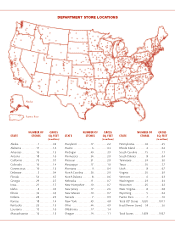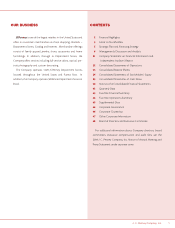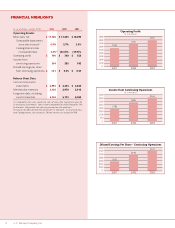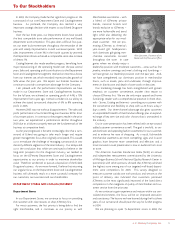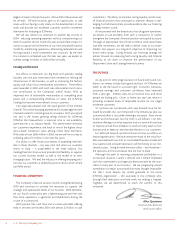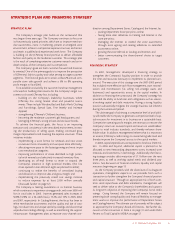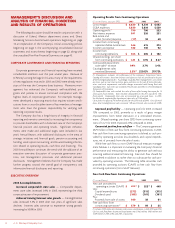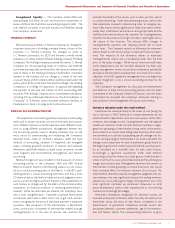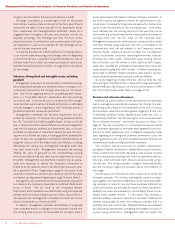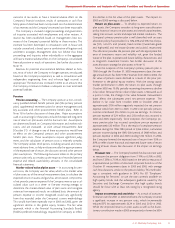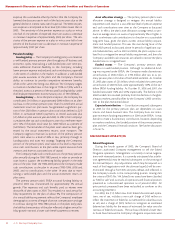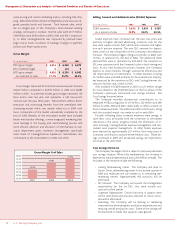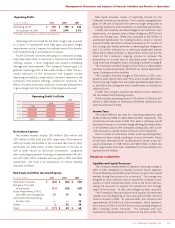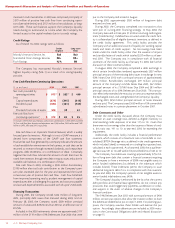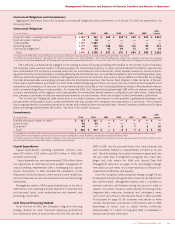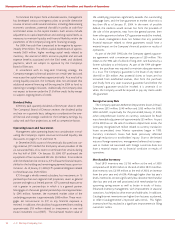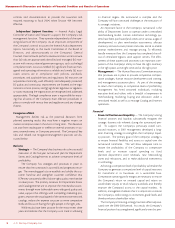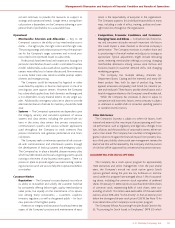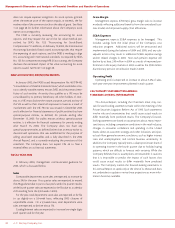JCPenney 2003 Annual Report Download - page 12
Download and view the complete annual report
Please find page 12 of the 2003 JCPenney annual report below. You can navigate through the pages in the report by either clicking on the pages listed below, or by using the keyword search tool below to find specific information within the annual report.
J. C. Penney Company, Inc.10
Management’s Discussion and Analysis of Financial Condition and Results of Operations
expense, this is somewhat offset by the fact that the Company has
lowered the discount rate in each of the last two years due to the
general decline in interest rates over this period. The 2004 net pen-
sion expense is anticipated to be at least $30 million lower than in
2003. The sensitivity of the pension expense to a plus or minus
one-half of one percent of expected return on assets is a decrease
or increase in expense of approximately $0.03 per share. The sen-
sitivity of the pension expense to a plus or minus one-half of one
percent of the discount rate is a decrease or increase in expense of
approximately $0.07 per share.
Pension Funding:
Funding policy — The Company’s funding policy is to maintain
a well-funded primary pension plan throughout all business and
economic cycles. Maintaining a well-funded plan over time pro-
vides additional financial flexibility to the Company, including
lower pension expense and reduced cash contributions, especially
in the event of a decline in the market. In addition, a well-funded
plan assures associates of the plan’s and the Company’s financial
ability to continue to provide competitive retirement benefits,
while at the same time being cost effective. The Company targets
to maintain a funded ratio in the range of 110% to 130%, which is
the plan’s assets as a percent of the actuarial funding liability under
the Employee Retirement Income Security Act of 1974 (ERISA).
Funding history — Since the plan’s inception, the Company has
contributed $1.4 billion, or approximately $840 million on an after-
tax basis, to the primary pension plan. Over this timeframe, actual
investment return on plan assets has generated a significant por-
tion of the $5.8 billion in pension plan total value, defined as $2.3
billion in cumulative benefit payments to retired associates plus
$3.5 billion in plan assets at year-end 2003. In effect, the Company’s
cumulative after tax cash contributions over this timeframe repre-
sent 14% of the plan’s total value (i.e., $840 million as a percent of
$5.8 billion). The remainder of the plan’s total value has been gen-
erated by the actual investment returns since inception. The
Company targets to maintain its portion of the primary pension
plan’s total value to a level of 20% or less, primarily through its
funding policy and asset mix strategy. Targeting the Company’s
portion of the pension plan’s total value at this level is important
since cash contributions to the plan utilize capital resources from
investors and have an associated cost of capital.
The Company made cash contributions to the primary pension
plan annually during the 1966-1983 period in order to provide an
asset base to support the accelerating liability growth in the early
years of the plan. Over the 1984-2003 period the Company made
cash contributions to the plan in six years (1993-1996, 2002 and
2003), and no contributions in the other 14 years due to main-
taining a well-funded plan and the actual investment return on
plan assets.
The primary pension plan’s ERISA actuarial funding liability at
year-end 2003 was characterized by approximately 3% annual
growth. Plan expenses and cash benefits paid to retirees were
about 6% of plan assets in 2003. This resulted in a total annual lia-
bility requirement for the plan of about 9%. The composition of
this annual liability requirement reflects the Company’s employee
demographics in terms of length of service, compensation and age.
In contrast, during the 1966-1983 period, or the plan’s early years,
the liability characteristics of the plan reflected a higher annual lia-
bility growth rate and a lower cash benefit payment to retirees.
Asset allocation strategy — The primary pension plan’s asset
allocation strategy is designed to mitigate this annual liability
requirement and result in a cost-effective level of pension expense
and cash contributions over time to the Company as discussed
above. In effect, the plan’s asset allocation strategy needs to pro-
duce an average return on assets of approximately 9% or higher in
order to eliminate cash contributions to the plan on a sustainable
long-term basis, given the plan’s current annual liability require-
ment and funded position. This was the case during most of the
1984-2003 period as discussed above. In periods of significant cap-
ital market declines, such as 2001 and 2002, the plan’s surplus is uti-
lized first to mitigate the annual liability requirement, and then the
Company’s available cash resources are utilized to restore the plan’s
funded ratio to a targeted level.
Funded status — The Company’s primary pension plan
remains in a well-funded position. Although no additional fund-
ing was required under ERISA, the Company made discretionary
contributions of $300 million, or $190 million after tax, to its pri-
mary pension plan in October of both 2003 and 2002. At October
31, 2003, plan assets of $3.5 billion, which included the current year
contribution of $300 million, were approximately 129% of the $2.7
billion ERISA funding liability. At October 31, 2002 and 2001, the
funded ratios were 112% and 121%, respectively. The decline in the
2002 funded ratio resulted primarily from the declines in the glob-
al equity markets, partially offset by the Company’s 2002 contribu-
tion to the plan mentioned above.
Expected contributions — Contributions required subsequent
to 2003 for the primary pension plan are dependent on asset
returns and future discount rates. The Company does not antici-
pate minimum funding requirements in 2004 under ERISA. It may
decide to make a discretionary contribution, however, depending
on market conditions, the funded position of the primary pension
plan and the Company’s financial condition. See further discussion
in Note 15.
DISCONTINUED OPERATIONS
Eckerd Drugstores
During the fourth quarter of 2003, the Company’s Board of
Directors authorized Company management to sell the Eckerd
Drugstore operation. Management is currently in active negotia-
tions with interested parties. It is currently anticipated that a defin-
itive agreement(s) may be reached subsequent to the printing of
this Annual Report. Any adjustments which may be required as a
result of final negotiations with the ultimate buyer(s) will be com-
municated through a Form 8-K and press release, and reflected in
the Company’s results in the corresponding quarter. Having met
the criteria of SFAS No. 144, Eckerd’s net assets have been classified
as “held for sale” and its results of operations and financial position
presented as a discontinued operation as of year-end 2003. All
prior periods presented have been reclassified to conform to this
accounting treatment.
For 2003, the $1.3 billion loss from Eckerd discontinued opera-
tions, net of tax, includes a non-cash charge of $450 million to
reflect the investment in Eckerd at its estimated fair value less costs
to sell, and a charge of $875 million to recognize an estimated
deferred tax liability for the excess of estimated fair value over the
tax basis of Eckerd’s net assets. The tax basis of Eckerd is lower than
its book basis because the Company’s drugstore acquisitions were


